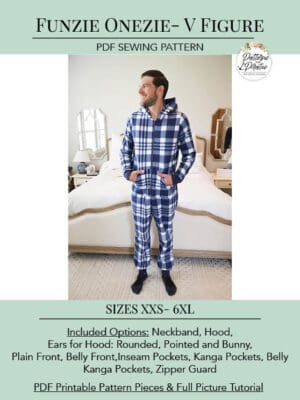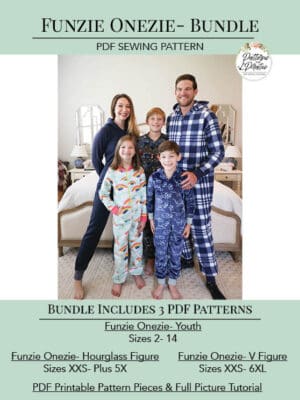Have you heard about P4P’s Peg Legs? And no, we are not talking about those wooden pirate legs! P4P released the Peg Legs some months back in celebration of reaching 5k members in the P4P Facebook Group. (crazy right!?!? since we just celebrated reaching 15k members last month!) If you don’t have them, you can grab them HERE and don’t forget to join the Facebook Group for a special promo code (check the pinned post for details)! In the last few months, we’ve seen the good, the bad, the fails and the “HAAALLPP” questions posted frequently. So, just like any introductory 101 college course, we are going to give you all the basics with this crash course to make a successful pair of Peg Legs!
First and foremost, if you are new to P4P, check out our First Time User Tips. Pattern Assembly, a few fabric shops, general cutting instructions, and sewing machine stitches are all discussed there. So now that you’re familiarized with P4P, here we go!
- What are Peg Legs? A classic mid-rise, tight fit leggings pattern for 4 way stretch knit fabrics. Options include 4 lengths: shorties, bike, capri and ankle with a no elastic waistband.
- Sizes Included: XXS – Plus 3x
- Fabric Recommendations: 4 way stretch knit with at least 50% stretch (vertically and horizontally). Typically 5% spandex or more will work.
- Cotton Lycra/spandex (note- Lycra=spandex). Medium weight is usually 10oz or more
- Rayon spandex. This is typically thinner so may not be opaque. One of our tunic tops to cover your booty are a MUST 😉
- Nylon spandex / Supplex – great for performance wear. This usually has a higher content of spandex and will feel tighter, much like compression wear. Some prefer to size up 1 for a more comfortable fit.
- Polyester spandex – brushed polyester spandex is what many of the boutique leggings are made from however, it is a slightly harder to find the fabric in retail stores. Be sure to check the vertical stretch percentage as some may be less than the 50% require stretch.
- Stretch Fleece – Fabrics such as Polartec Powerstretch are a 4 way stretch fleece. Regular fleece, like blizzard, anti-pill and cuddle fleece found in retail stores are NOT recommended.
Fabric is extremely important to get an accurate fit. Here is an example of the same size medium, capri length made from a 2 way stretch ponte de roma and a 4 way stretch rayon spandex. You can see the overall fit of the 2 way stretch is much shorter in length and has a lower rise. I am able to put on the 2 way stretch pair but because there is no vertical stretch, they do not stretch and bend with movement and tend to slip down over time. While they are a super cute fabric, sadly, they sit in my drawer as they are not comfortable to wear.
STRETCH PERCENTAGES
So, you ask, how do I know if my fabric is 4 way 50% stretch knit? A 4″ piece will stretch to a minimum of 6″ both vertically and horizontally. Below is a stretch percentage guide. Cut a scrap piece of your fabric 4″ x 4″. Fold in half so it is now 2″ x 4″ and place at the end of the stretch guide. Hold fabric at one end (where indicated) and grab the opposite end and stretch. If you can stretch the fabric to 5.2″, your fabric has 30% stretch, 5.7 is 40% and so on. Unfold and refold the opposite direction and test again. To determine horizontal stretch, your grainline will run vertically with the stretch perpendicular and horizontal. The vertical stretch is with the grainline. For a printable copy, head on over to our Facebook Group and download a copy from the files section. 🙂 Need more help? Megan from Made from Mermaids has a great blog post with video about stretching fabrics. You can check it out HERE.
PICKING YOUR SIZE
Now that you have checked your fabric, how do you pick your size? If you are unsure on how to measure your body, check out our “How to Measure Yourself” post. The peg legs use the high hip (where your hip bones are) and the hip (across the fullest part of your booty) measurements to determine size. If you are in different sizes for your high hip and hip, you can grade between the two or use one size for the waistband and the other for your “legs”. This works best for those that have a high hip 1 size smaller than their hip. If your high hip is larger than your hip, it would be best to grade your sizes.
ADJUSTING THE RISE AND LENGTH
The Peg Legs are a mid rise legging, meant to hit under your belly button. For those wanting a higher rise or more tummy coverage, you can either add a taller waistband than the pattern calls for or increase the rise of the legs and use the existing waistband measurements.
- Taller waistband: increase height of waistband to 10″ instead of 7″
- Fold Over Yoga Band: double the height of waistband to 14″
To increase the rise of the legs: 1) follow the curve of the rise to a larger size on the pattern and blend. OR 2) Slash and Spread – Cut the pattern horizontally through the rise, add the desired amount and smooth out the curves.
Our patterns are drafted for a curvy 5’5″ frame. Using the same principle as found in our Petite & Tall Fitting Adjustment post, you will adjust your length of the legs by 1/2″ for every 1″ over or under 5’5″. The Peg Legs’ have a 28″ inseam for ankle length. If your inseam is shorter or longer, you will adjust to your desired length in the same manner.
- Determine the amount you need to adjust your length by. Using the principle above – A 5’10” woman would need an additional 2.5″ (5’10” – 5’5″ = 5″ ~ 5″ x .5″ = 2.5″ ). A 5″1″ woman would need 2″ subtracted (5’1″ – 5’5″ = 4″ ~ 4″ x .5″ = 2″). It is best to split the total length that needs to be added or subtracted throughout the entire leg. Slash and spread the pattern in equal parts and blend the lines. The most common areas to adjust are the shorties, bike, and capri lengths as there are cut lines already indicated on the pattern. You may also need to adjust the rise, higher or lower depending on your desired height.
CUTTING YOUR FABRIC
You will need the following: 2 legs (mirror images) and 1 waistband. Note: the greatest stretch should be horizontal and what goes around the body. To create mirror images you can cut your fabric two ways:
- Cut 1 pattern piece with pattern writing face up. Flip your pattern piece over and cut again.
- Cut your pattern piece with fabric on the fold to create mirror images with 1 cut.
Once you’ve assembled your pattern, pre-washed your fabric and cut your pattern pieces you are ready to sew up a pair! Because this is a great beginning knit project, we have included a quick video tutorial! Enjoy!
Sewn up a pair of Peg Legs? We would love to see what you are all creating. Join the Facebook Group and share away.













Fantastic! A video is worth a thousand printed words for me. Thank you!
I echo Laurie’s comment – so helpful thanks for putting up this page.
Ahhhh! Thank you SO MUCH for the video tutorial! I am a visual learner and the pattern had me dumbfounded at points. Now it all makes sense. Yay! I can’t wait to make my peg legs this week!